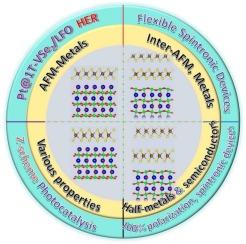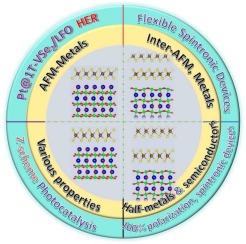Interface engineering of VSe2/LaFeO3 vertical heterostructures: modulation of magnetic and electronic properties
IF 6.9
2区 材料科学
Q2 CHEMISTRY, PHYSICAL
引用次数: 0
Abstract
We performed first-principles calculations based on density functional theory to investigate the atomic structure, electronic properties, and magnetic behavior of monolayer and bilayer 1T- and H-VSe2 adsorbed on the (001) surface of LaFeO3 (LFO) with LaO and FeO2 termination layers, respectively. Our findings reveal that both monolayer and bilayer VSe2 can stably adhere to the LFO (001) surface. Monolayer 1T- and H-VSe2 exhibit ferromagnetic (FM) characteristics, where the 1T phase is metallic and the H phase is semiconducting. Charge transfer from LFO to VSe2 induces the reversal of the magnetic moments for specific V atoms in VSe2, leading to in-plane antiferromagnetic (AFM) properties. Monolayer 1T-VSe2 on the LFO surface retains metallic, whereas monolayer H phase exhibits diverse behaviors: some configurations preserve their semiconducting properties, while others transition to metallic states. For bilayer VSe2/LFO heterostructures, both 1T- and H-bilayer VSe2 exhibit interlayer AFM alignment and in-plane FM states. Bilayer 1T-VSe2 maintains its metallic character, while bilayer H-VSe2 with LaO termination exhibits half-metallic properties, and that with FeO2 termination retains semiconducting, enabling tunable half-metal/semiconductor transitions via LFO substrate engineering. Finally, we explored the hydrogen evolution reaction (HER) catalytic performance of single-atom Pt-doped VSe2 with and without the LFO (001) substrate. The results indicate that the presence of the LFO substrate significantly enhances the stability of single-atom Pt on VSe2 and improves the HER catalytic efficiency for Pt-doped monolayer VSe2. Additionally, the monolayer H-VSe2/LFO heterostructure demonstrates potential for Z-scheme photocatalytic applications.


VSe2/LaFeO3垂直异质结构的界面工程:磁性和电子性质的调制
基于密度泛函理论,研究了lao3 (LFO)表面分别吸附有lao2和FeO2端接层的单层和双层1T-和H-VSe2的原子结构、电子性能和磁性行为。我们的研究结果表明,单层和双层VSe2都可以稳定地粘附在LFO(001)表面。单层1T-和H- vse2表现出铁磁性(FM)特性,其中1T相是金属相,H相是半导体相。从LFO到VSe2的电荷转移引起VSe2中特定V原子的磁矩反转,从而导致面内反铁磁(AFM)性质。LFO表面的单层1T-VSe2保留了金属性质,而单层H相表现出不同的行为:一些构型保留了半导体性质,而其他构型则转变为金属态。对于双层VSe2/LFO异质结构,1T-和h -双层VSe2均表现出层间AFM取向和面内FM态。双分子层1T-VSe2保持其金属性质,而双分子层H-VSe2具有LaO端接的半金属性质,而具有FeO2端接的双分子层H-VSe2保留了半导体性质,通过LFO衬底工程实现了可调的半金属/半导体转变。最后,我们探索了单原子掺杂pt的VSe2在有和没有LFO(001)底物的情况下的析氢反应(HER)催化性能。结果表明,LFO底物的存在显著增强了单原子Pt在VSe2上的稳定性,提高了掺杂Pt的单层VSe2的HER催化效率。此外,单层H-VSe2/LFO异质结构显示了Z-scheme光催化应用的潜力。
本文章由计算机程序翻译,如有差异,请以英文原文为准。
求助全文
约1分钟内获得全文
求助全文
来源期刊

Applied Surface Science
工程技术-材料科学:膜
CiteScore
12.50
自引率
7.50%
发文量
3393
审稿时长
67 days
期刊介绍:
Applied Surface Science covers topics contributing to a better understanding of surfaces, interfaces, nanostructures and their applications. The journal is concerned with scientific research on the atomic and molecular level of material properties determined with specific surface analytical techniques and/or computational methods, as well as the processing of such structures.
 求助内容:
求助内容: 应助结果提醒方式:
应助结果提醒方式:


